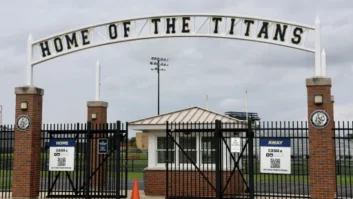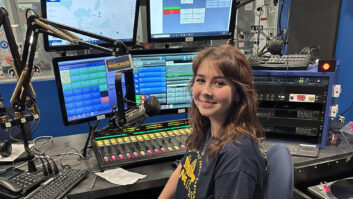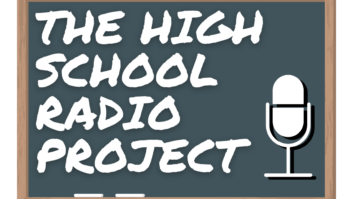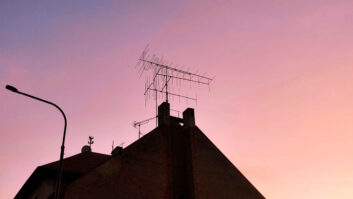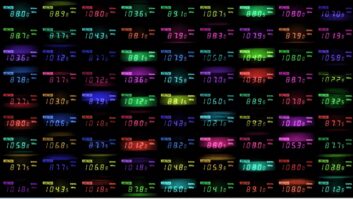There is a little 380 watt noncommercial radio station in Pittsfield, Mass., that won’t take no for an answer.
In June, 89.7 WTBR(FM), owned by the Pittsfield school system, became the first station in western Massachusetts to not only take part in the American Cancer Society’s “Relay for Life” in Berkshire County Central/South but to move its studios to the site and broadcast the entire event in stereo. They did, in a remote that lasted 26 hours.

Students get silly with SpongeBob at the Relay for Life. WTBR is my passion. The Taconic High School station allows us to teach students about the real world of radio; they can operate a station with a classic rock/new rock format and even do voice tracking.
The Relay for Life event celebrates the lives of people who have battled cancer. It helps them remember loved ones and fight back against the disease. Teams camp and take turns walking or running around a track or path; each is asked to have a representative on the track at all times. Relays continue overnight, “because cancer never sleeps.”
The idea for the broadcast came from students; they asked me if they could do a remote from “Relay.” Not so simple, considering that the station did not own RPU equipment and operates on a shoestring budget. To make matters more difficult, the Relay for Life is held at a local lake in an area from which even RPU units find it difficult to deliver signal.
Engineer Tom Harrison had been working on an inexpensive way to broadcast music remotes via the Internet; he and I said we would consider the challenge.
Wired up
Fast forward two years. On Tom’s recommendation the station had purchased Barix Instreamer 100 and Exstreamer 100 boxes, allowing us to connect to the public Internet with MP3 compressed audio links at a varying bit rate that depends on the speed of the Internet link.
We conducted several “experimental” stereo remotes to test the system using DSL, cable and even WiFi. Our first broadcast was from a local volunteer fire department fundraiser.
Now everything was in place except for one important element: high-speed Internet at the site. Verizon agreed to donate and install a special business-class DSL line in a bathhouse near where our broadcast tent would be set up. Tom and several other volunteers began building the studio in a 12×12 canopy tent at 9 a.m. on the morning of Relay; by 1 p.m. they were sending a signal to the studio via the DSL line.

Not yet a high school sophomore, DJ Jen Norton participated in the Relay broadcast. ‘These are kids who knew only their iPods until they got into radio,’ says advisor Larry Kratka. ‘Now they’re listening to their own station and are proud of it.’ “We set the Barix boxes initially for 160 kbps joint stereo,” Tom Harrison explained, “but actually increased the bit rate to 224 kbps joint stereo due to a good connection.
“This is one-way audio, just a stream inbound to the station. With additional equipment we’d be able to send audio outbound to the tent, but did not have the need due to good coverage from our main transmitter for off-air monitoring. Our signal is delayed to the air by approximately 7 seconds at these bit rates; we do not find that objectionable.”
Tom recommends this Barix system to others looking for a “plug-and-play” high-quality stereo remote solution, where all functions of the station are brought to the remote site.
“Our Exstreamer box is wired through our automation system, where we can log into the automation remotely, push a few buttons, and the Exstreamer is on the air with no human presence required at the studios,” he explained.
“If the boxes get disconnected, they automatically try to reconnect. We also had a return command put into the log about 20 minutes after the remote was scheduled to end, so the automation would take control back if we had any difficulty with the connection.”
Equipment for the remote consisted of a Behringer 1622 mixer, FBT powered mixer, three Sennheiser MD 421 mics, an EV wireless mic, two Sennheiser HMD 280 Pro headsets, Rolls headphone amp, a Behringer PA system, the 12×12 canopy, the Barix codecs and five laptop computers (three for music, liners and underwriting announcements, two for tech support and control of the studio computer) … and many fans, to help us cope with the heat.
Students who could
Eleven students who have shows signed up for two-hour shifts between 2 and 10 p.m. Friday and again from 8 a.m. to 4 p.m. Saturday; and many others actually showed up. Adult volunteers took the overnight hours. All were helped by Tom Harrison, adult volunteer broadcast coordinator Brad Lorenz and Relay for Life student PD Billy Madewell IV.
The Relay for Life organizers urged their teams to bring along boom boxes and portable FM receivers because WTBR planned on carrying all special Relay announcements plus the opening ceremony, the Survivor Lap ceremony and the Luminary ceremony “live” from the entertainment tent.

Student PD Billy Madewell, left, works the tent with engineer Tom Harrison. WTBR raised money for the American Cancer Society by asking people at the site to drop money in a coffee can for requests or shout-outs. By Saturday afternoon, the can was brimming. Listeners heard everything that went on at the Relay; many made the trip to donate or take part.
I found it remarkable that students who’d just gotten out of school for the summer still wanted to take part in what was, for us, a massive broadcast. Other commercial stations in Pittsfield — including our “Partner in Education,” Vox Communications’ WUPE(AM/FM) and WBEC(FM), as well as crosstown WBRK(AM) — sent air personalities to cover Relay with special reports.
Readers may remember when AM stations used to pack up the Collins turntable and mixer, take it to a remote site and plug it into a phone line or Marti.
Several of us involved in this project wondered how much the remote would have cost in salaries if this had been a commercial station project. Probably way too much in this day and age — but it sure makes an impression on listeners.
The local newspaper dubbed WTBR “The Little Station That Could.” They certainly did. Broadcasting’s future is with these kids. From what I can see, I think we’ll be OK.
The author is student advisor to WTBR(FM).

